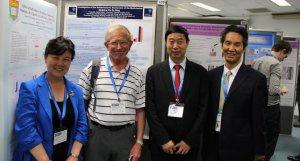心肌梗死PCI术后合并房颤慎用多重抗栓药物疗法
临床上可见多重抗栓药物引起的出血,包括心肌梗死冠脉介入术(PCI)后合并房颤使用三联药物抗栓疗法的患者。
多重抗栓药物疗法对于心肌梗死冠脉介入术(PCI)后合并房颤的患者的治疗效果仍有很多不确定性。研究者调查了发生心肌梗死后施行经皮下冠脉介入术(PCI)后出现房颤的患者使用多重抗栓药物疗法后发生出血的风险及时间窗。
研究纳入了丹麦2000年至2009年发生过心肌梗死并确诊房颤合并心梗的11480名患者,这些患者同时施行过冠脉介入术(PCI),在住院治疗期间经过抗栓治疗后出现过致命或轻微的出血。所用多重抗栓药物疗法包括:抗栓三联疗法维生素K拮抗剂+阿司匹林+氯吡格雷;维生素K拮抗剂+抗血小板药和阿司匹林+氯吡格雷双联抗血小板药物。研究者通过Cox回归模型评估了出血事件发生率,并调整了危险比。结果发现,1年内有728名(6.3%)患者发生出血,79名(0.7%)是致命性的。治疗30天内,上述三种抗栓疗法在每100名病人中的出血发生率分别为22.6%,20.3%,14.3%。治疗早期(90天内)和治疗后期(90-360天内)采用三联抗栓疗法的出血率高于维生素K拮抗剂+抗血小板药的疗法,危险比分别为1.47和1.36。
高风险出血是心肌梗死/冠脉介入术(PCI)后发生房颤患者采用三联抗栓疗法后出现的急性事件,三联抗栓疗法持续增高的出血风险提示该疗法不具安全窗,因此只有经过安全评估的心肌梗死患者才可使用三联抗栓疗法。
Abstract
Background—Uncertainty remains over optimal antithrombotic treatment of patients with atrial fibrillation presenting with myocardial infarction and/or undergoing percutaneous coronary intervention. We investigated the risk and time frame for bleeding following myocardial infarction/percutaneous coronary intervention in patients with atrial fibrillation according to antithrombotic treatment.
Methods and Results—Patients with atrial fibrillation and admitted with myocardial infarction or for percutaneous coronary intervention between 2000 and 2009 (11 480 subjects, mean age 75.6 years [SD ±10.3], males 60.9%) were identified by individual level linkage of nationwide registries in Denmark. Fatal or nonfatal (requiring hospitalization) bleeding was determined according to antithrombotic treatment regimen: t**le therapy (TT) with vitamin K antagonist (VKA)+aspirin+clopidogrel, VKA+antiplatelet, and dual antiplatelet therapy with aspirin+clopidogrel. We calculated crude incidence rates and adjusted hazard ratios by Cox regression models. Within 1 year, 728 bleeding events were recorded (6.3%); 79 were fatal (0.7%). Within 30 days, rates were 22.6, 20.3, and 14.3 bleeding events per 100 person-years for TT, VKA+antiplatelet, and dual antiplatelet therapy, respectively. Both early (within 90 days) and delayed (90–360 days) bleeding risk with TT exposure in relation to VKA+antiplatelet was increased; hazard ratio 1.47 (1.04;2.08) and 1.36 (0.95;1.95), respectively. No significant difference in thromboembolic risk was observed for TT versus VKA+antiplatelet; hazard ratio, 1.15 (0.95;1.40).
Conclusions—High risk of bleeding is immediately evident with TT after myocardial infarction/percutaneous coronary intervention in patients with atrial fibrillation. A continually elevated risk associated with TT indicates no safe therapeutic window, and TT should only be prescribed after thorough bleeding risk assessment of patients.
本站所注明来源为"爱爱医"的文章,版权归作者与本站共同所有,非经授权不得转载。
本站所有转载文章系出于传递更多信息之目的,且明确注明来源和作者,不希望被转载的媒体或个人可与我们
联系zlzs@120.net,我们将立即进行删除处理
热点图文
-
牛津大学:心速宁胶囊作用机制研究成果发表
2015年5月19日,由澳大利亚药理学会和英国药理学会主办的澳-英联合药理...[详细]
-
GM制药Epidiolex获FDA孤儿药资格
2月28日,GW制药宣布美国FDA授予该公司用于治疗儿童Lennox-Ga...[详细]


